Love and kill.
Editor’s note: This article is from WeChat public account “Connect Insight” (ID: lxinsight) .

This article is exclusively published in conjunction with Tencent News and may not be reproduced without permission.
Text / green pine
Edit / Shui Sheng
Lu Weibing, president of Xiaomi China, has never disappointed in the matter of “tearing Huawei.”
On March 24, Redmi K30 Pro flagship conference was held as scheduled. Throughout the conference, from performance to taking photos to the screen, Lu Weibing “touched the porcelain” Huawei Honor V30 Pro mobile phone, claiming that he has completely surpassed the Honor model from the above dimensions.
The conference even set the sandpaper free-fall drop test link of Redmi K30 Pro and Honor V30 Pro. In the test, the Honor V30 Pro three machines fell after the back cover was broken, but the Redmi K30 Pro was intact. Lossless.
Not only that, but Lu Weibing also gave this conference a special meaning. He regarded the release of the Redmi K30 Pro as the battle between the inflection point of the Redmi brand and the Honor brand, claiming to achieve a comprehensive surpass of Honor in 2020.
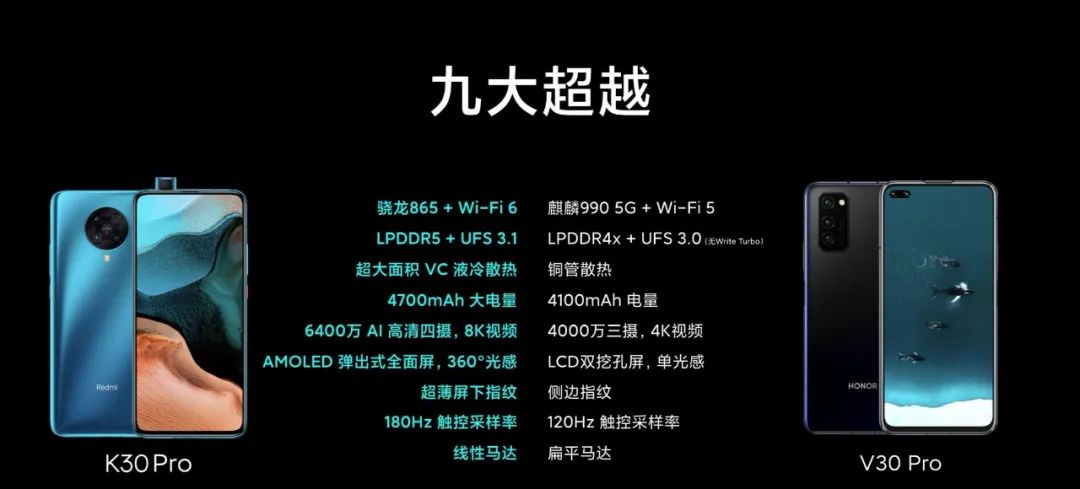
Tour source Lu Weibing personal Weibo
“This transcendence is not only a transcendence at the product level, but also a transcendence of the brand and an overall transcendence in sales in the Chinese market.”
But it is worth noting that the Honor V30 series mobile phone was released on November 26, 2019. Lu Weibing took the new Redmi K30 pro and V30 Pro to compare, making many “eating crowds” confused. CognitiveThe real benchmark for Redmi K30 pro should be the Honor 30S, which will be released on March 30.
As of now, Honor has not responded to this. Zhao Ming, President of Huawei’s Honor Business Department, and Yu Chengdong, CEO of Huawei Consumer Business, and Huawei Executive Director Yu Chengdong, rarely have expressions related to Xiaomi. Even on the eve of the launch of new Huawei P40 series and Honor 30S new devices, their warm-ups More low-key.
Pushing the time back to February 13, at the launch of the new Mi 10 series, Xiaomi founder Lei Jun has repeatedly benchmarked the new Mi 10 Pro with Huawei mate 30 Pro, also from the performance To take pictures to the screen, show no mercy.
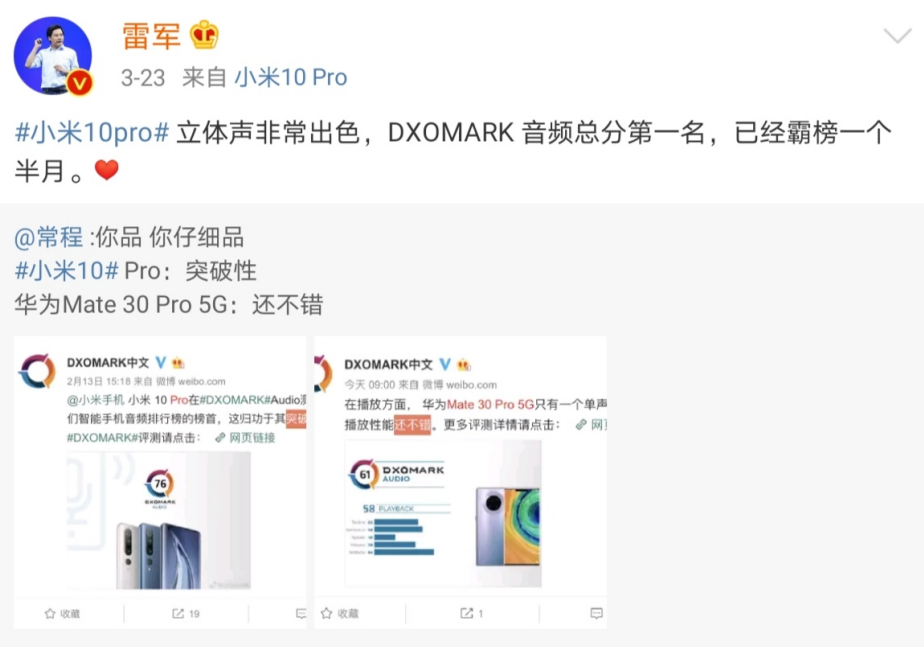
Lei Jun forwards a regular ridicule of Huawei Weibo, Tu Yuan Leijun Weibo
Zhao Ming said in an interview with NetEase on February 19 that he mentioned Honor and Xiaomi ’s drool war, saying that “the brainless blackness makes everyone unable to think calmly, and it will also break up the relationship between people.” He is more willing to follow a sentence that Huawei regards as a classic: products are the strategic force for ultimate victory, and Glory should insist on competing around product, technology and technological innovation.
On March 9, when Yu Chengdong exposed Huawei ’s global flagship store in Paris, France on Weibo, he said something meaningful: “The brand is not advertised, it is a type.” Suspicious response to Xiaomi .
One hard and one hidden needle on both sides contributed to a wonderful war of tears.
Xiaomi is the more radical party in this year’s “big battle”. Words such as “comprehensive crushing” and “full transcendence” became the keywords of “Huawei” and “Glory” at the press conference of Xiaomi and Redmi.
Interestingly, the Huawei P40 new machine launch conference will be held tonight, but as early as when Huawei officially announced the new machine launch, Xiaomi will issue an announcement through an overseas account. The re-launch of the Xiaomi Mi 10 global press conference in London can be described as step by step.
This makes people curious: why with so many mobile phone manufacturers, why does Xiaomi aim the gun at Huawei? Xiaomi executives repeatedly whispered behind Huawei, what are they thinking?
A brief history of Xiaomi and Huawei tearing each other
The “tearing history” between Xiaomi and Glory goes back to 2013. Since then, Xiaomi and Huawei have begun a journey of “love and kill each other”. In this journey, 2015The beginning of “cross-evil”.
Huawei is a latecomer in making mobile phones.
In 2012, Yu Chengdong once publicly stated on Weibo that “Huawei also developed from a small company. When joining Huawei 19 years ago, the company was not larger than Xiaomi today. I am the same age as Lei Jun and I am in mobile communications The Internet field has been beaten for many years and is considered a veteran, but it is definitely a novice in the Internet field. Many need to learn from Lei Zong and the elites in the Internet field.
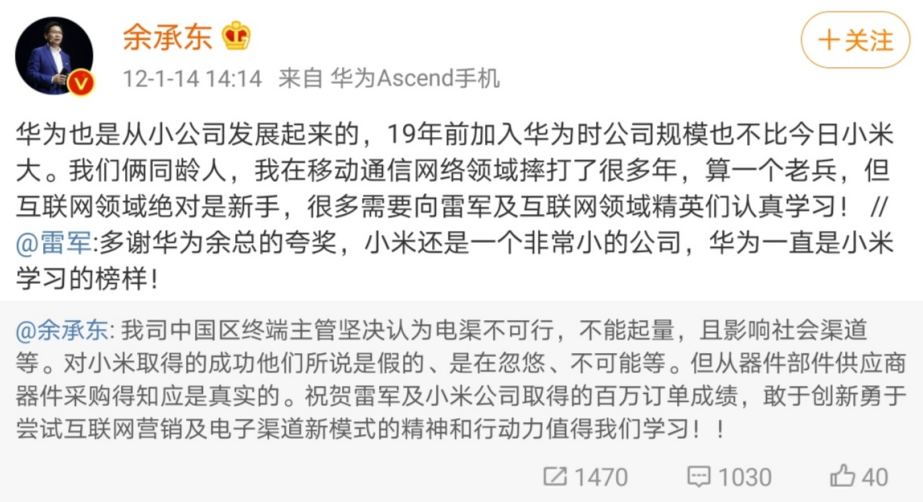
Tuyuan Yu Chengdong’s personal Weibo
By 2013, Xiaomi launched the Redmi brand, and Huawei announced that it will be independent of the Honor brand.
At the beginning of Glory’s independence, the market positioning was similar to that of Red Rice, which focused on the thousand-yuan machine market. At that time, a mobile phone enthusiast told Tencent Technology, “The Honor 3C, the first mobile phone after Honor’s independence, has almost the same appearance and configuration as Redmi, which puts Honor and Redmi on almost the same product positioning.” >
That time was the highlight of Xiaomi, and the Honor brand was also steadily rising. According to market research institute IDC’s China smartphone survey data for the fourth quarter of 2014, Xiaomi relied on the Xiaomi Mi 4 and Xiaomi Mi phones to ship more than 60 million units throughout the year, accounting for 12.5% of the domestic market. Overtaken Samsung in the domestic market.
Honor also has a firm foothold in the domestic market with its two low-end products, the Honor 3X and Honor 4X, and the Honor 6 series mid-range phones. By the end of 2014, Honor had sales of 20 million units and revenue of US $ 2.4 billion.
At that time, Xiaomi and Glory still had a close relationship. Lin Bin and Yu Chengdong, then presidents of Xiaomi, intersect on Weibo, often even standing on each other’s platforms, and the atmosphere is peaceful.
By 2015, Huawei is fully developing its strength from the low-end to the high-end market. IDC data shows that in the 2015 Q4 vendors ’smartphone shipments, Huawei ranked first with 17.9 million units. The shipment of smartphones reached 108 million units in the year. The Huawei Mate7 series of phones released in September 2014 marked the emergence of Huawei in the high-end mobile phone market.
Xiaomi was in trouble because of quality control issues during the same period. The false publicity of the Redmi note2 screen, the ineffectiveness of the Qualcomm Snapdragon 810 processor, and the implantation of a large number of MIUI7 advertisements have continued to lower the reputation of Xiaomi, and its revenue has declined compared to 2014.
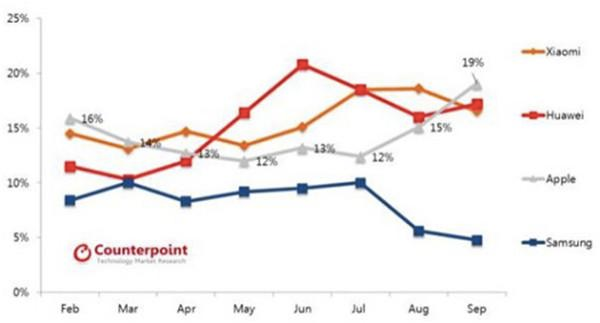
Apple, Samsung, Huawei, and Xiaomi market share statistics from February to September 2015, Figure Source Counterpoint
In this confrontation between Huawei and Xiaomi, 2015 was a watershed year. Huawei’s catch-up has made the competitive relationship between the two parties even more obvious, and the competition has subsequently developed into a “word battle” between executives.
In 2015, Yu Chengdong said at the Mobile World Congress that the smartphone industry will be reshuffled. There will be only three major mobile phone manufacturers in the next three to five years. When referring to Xiaomi, he said: “Many mobile phone manufacturers look at It was very successful, but they will disappear soon. In the long run, I don’t think they can survive. “
Since then, the two companies have begun to bury each other. In 2018, this war of tears has reached its climax.
In May of that year, Honor Mobile officially announced that it will release Honor Play on June 6, which will debut Huawei’s “very scary technology.” Xiaomi then stated that “Xiaomi Mi 8 has a lot of very scary technology”, and the smell of gunpowder began to thicken . In response, Huawei directly responded by saying that it has a lot of technology, “Want to learn? It’s hard, learn it well.”
Lenovo has also come out to make fun, “Don’t be afraid, scary things are all associated”, the official poster of Lenovo said so. As a result, Xiaomi and the glory of gunpowder have been upgraded across the board.
On September 7, 2018, Honor released the new Honor 8X. At the press conference, Honor compared Xiaomi 8 and pointed out that Honor 8X outperformed Xiaomi 8 in many aspects.
In the evening of the same day, the vice president of the Honor Business Department posted a Weibo, saying, “The Honor 8X makes friends feel painful and can’t sit still. I’m glad, sorry.” Zhao Ming then forwarded this Weibo.
Next, glory revolves around the newly released sports bracelet, again referring to Xiaomi. In the posters released by it, “Don’t agree? Then convince”, “Glory bracelet 4 series, all kinds of dissatisfaction” Such provocative words are quite explicit.
By the end of 2019, starting with Xiaomi public relations Panda’s Weibo publicly questioning the existence of false publicity for the glory smart screen, Xiaomi and glory launched a drool war for a week, and finally had to live through a teardown. Quit the war.
In the end, the dispute ended with Weibo Lu acknowledging that there was a gap with the Honor Smart Screen.
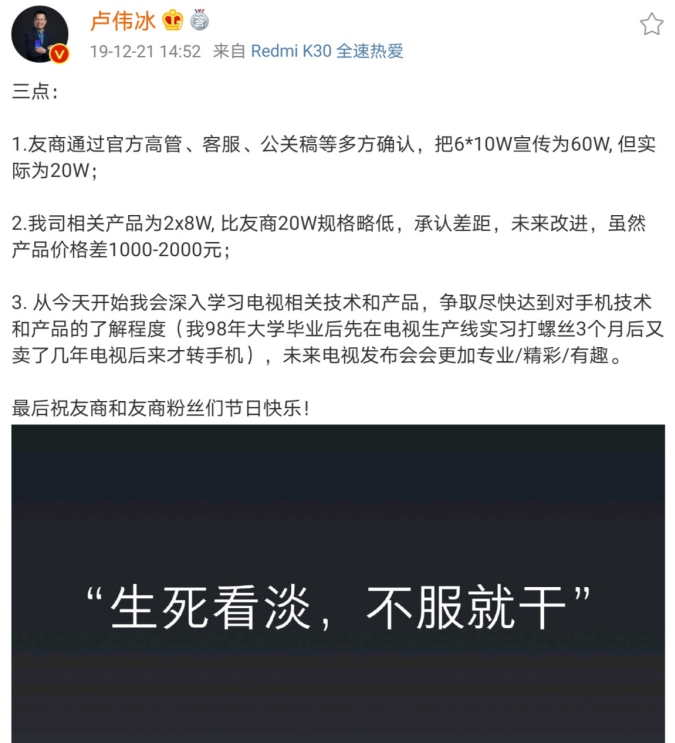
Tour source Lu Weibing personal Weibo
But the tearing of Xiaomi and Glory is far from over. It is foreseeable that this phenomenon will still occur when new machines are released next.
It is interesting to note that in the process of tearing each other, the target objects are different.
In 2018, the Honor 8X and Xiaomi Mi 8 were torn apart, but the Honor 8X is in the middle and low end in Huawei’s product line, and Xiaomi Mi 8 is Xiaomi’s flagship product.
“Xiaomi now compares Xiaomi series and Redmi series with Huawei and Glory, but Huawei has always intended to use the Honor series to benchmark the entire Xiaomi. In this respect, the two sides are different.” Dean Sun Yanji said to Connect Insight.
Xiaomi targets the truth behind Huawei
Executives have stepped down to talk to each other, not for the sake of talking.
In the battle between Xiaomi and Huawei, Lu Weibing is a key figure.
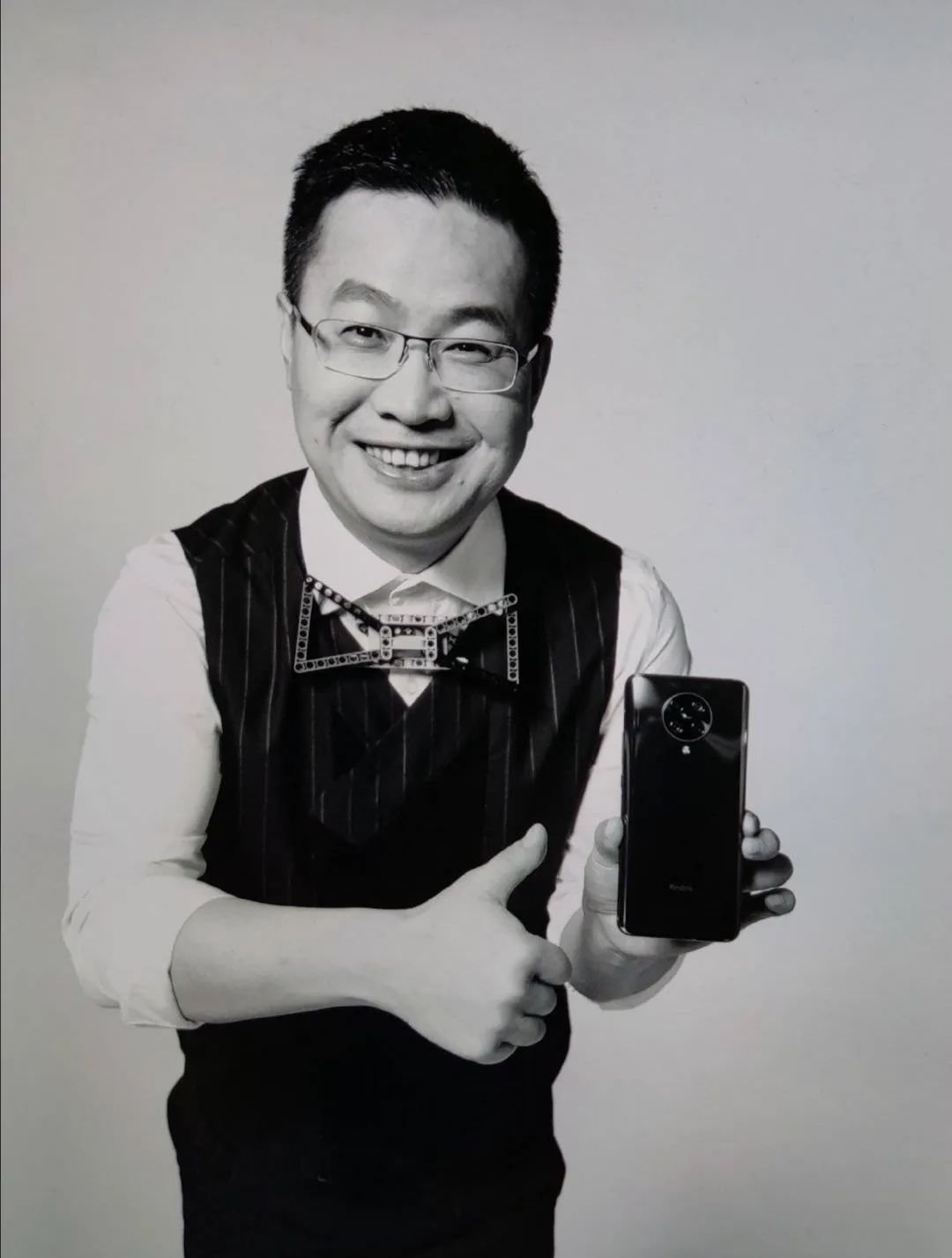
Lu Weibing, Tu Yuan’s personal Weibo
He joined Xiaomi in early 2019. During the same period, Xiaomi announced that the Redmi Redmi brand is officially independent. Over the next year or so, Lu Weibing pointed his finger directly at the glory, and the benchmarking between the Redmi brand and the glory brand intensified.
It is also from the independence of the Redmi brand that Xiaomi has become more targeted to Huawei’s “salary war”. Xiaomi series of phones are benchmarked against the Huawei mate series and P series, and the Redmi series is mainly benchmarked against the Honor series.
This may explain why Xiaomi is targeting Huawei. From the independence of the Honor brand in 2013 to the great success of the Huawei Mate7 series in 2015, which officially entered the high-end market, Huawei’s dual-brand strategy has been firmly established for five years.
Xiaomi was one of the top players in the domestic mobile phone market with Internet marketing. But before 2019, its product layout was not clear. At that time, whether it was the Xiaomi brand or the Redmi brand, there was a lot of overlap in price. Cost-effective label.
To break this deadlock, the hardest part is how to reshape brand perception. The simplest and rude way is to “leverage” Huawei, not to mention, looking at the domestic mobile phone market, the most representative of the two fronts in the low-end market and high-end market is also Huawei.

Price comparison between Redmi and some Honor models, connected with Insight mapping
Among them, Lu Weibing’s style change from Gionee to Huawei is very telling.
Before joining Xiaomi, Lu Weibing served as the president of Gionee Group for 9 years. During this period, the mobile phone market has completed the transformation from feature phones to smart phones, and has gone from 2G to 3G to 4G. Upgrade, but until the rumors of bankruptcy in 2018, Gionee can be described as a force that cannot be ignored in domestic mobile phones.
In Gionee ’s resume, Lu Weibing not only led the expansion of Gionee ’s smartphone business overseas, but also led the rejuvenation of Gionee ’s smartphone brand from 2014.
Lu Weibing was very low-key at that time. Unlike executives such as Lei Jun and Yu Chengdong, who frequently appear and speak, Lu Weibing is more like a pusher behind the scenes, and has not pushed himself to the public. Even in 2017 when Gionee started marketing aggressively, Lu Weibing was not the central figure on the mobile phone stage.
But just one year after joining Xiaomi, Lu Weibing has become one of the few topic figures in the mobile phone circle, and frequently relies on “tearing Huawei” to arouse public attention.
Even if you search for “Lu Weibing” on Weibo, most of the extended terms are “Lu Weibing tears glory”, “Lu Weibing returns to Yu Chengdong”, “Did Lu Weibing smash people today?”

Weibo search “Lu Weibing” display interface, picture source Weibo
In the Xiaomi system that is well versed in Internet marketing, Lu Weibing’s transformation is very representative. And his mutual enthusiasm with glory, and Lei Jun stepped down to praise Huawei’s high-end series, and realized the mutual cooperation in reshaping the Xiaomi brand awareness in the product line. Through this seemingly “not friendly” approach, consumers’ deeper understanding of Xiaomi’s dual brands is constantly being developed. Perhaps it is Xiaomi such as



Executives have stepped down to talk to each other, not for the sake of talking.
In the battle between Xiaomi and Huawei, Lu Weibing is a key figure.

Lu Weibing, Tu Yuan’s personal Weibo
He joined Xiaomi in early 2019. During the same period, Xiaomi announced that the Redmi Redmi brand is officially independent. Over the next year or so, Lu Weibing pointed his finger directly at the glory, and the benchmarking between the Redmi brand and the glory brand intensified.
It is also from the independence of the Redmi brand that Xiaomi has become more targeted to Huawei’s “salary war”. Xiaomi series of phones are benchmarked against the Huawei mate series and P series, and the Redmi series is mainly benchmarked against the Honor series.
This may explain why Xiaomi is targeting Huawei. From the independence of the Honor brand in 2013 to the great success of the Huawei Mate7 series in 2015, which officially entered the high-end market, Huawei’s dual-brand strategy has been firmly established for five years.
Xiaomi was one of the top players in the domestic mobile phone market with Internet marketing. But before 2019, its product layout was not clear. At that time, whether it was the Xiaomi brand or the Redmi brand, there was a lot of overlap in price. Cost-effective label.
To break this deadlock, the hardest part is how to reshape brand perception. The simplest and rude way is to “leverage” Huawei, not to mention, looking at the domestic mobile phone market, the most representative of the two fronts in the low-end market and high-end market is also Huawei.

Price comparison between Redmi and some Honor models, connected with Insight mapping
Among them, Lu Weibing’s style change from Gionee to Huawei is very telling.
Before joining Xiaomi, Lu Weibing served as the president of Gionee Group for 9 years. During this period, the mobile phone market has completed the transformation from feature phones to smart phones, and has gone from 2G to 3G to 4G. Upgrade, but until the rumors of bankruptcy in 2018, Gionee can be described as a force that cannot be ignored in domestic mobile phones.
In Gionee ’s resume, Lu Weibing not only led the expansion of Gionee ’s smartphone business overseas, but also led the rejuvenation of Gionee ’s smartphone brand from 2014.
Lu Weibing was very low-key at that time. Unlike executives such as Lei Jun and Yu Chengdong, who frequently appear and speak, Lu Weibing is more like a pusher behind the scenes, and has not pushed himself to the public. Even in 2017 when Gionee started marketing aggressively, Lu Weibing was not the central figure on the mobile phone stage.
But just one year after joining Xiaomi, Lu Weibing has become one of the few topic figures in the mobile phone circle, and frequently relies on “tearing Huawei” to arouse public attention.
Even if you search for “Lu Weibing” on Weibo, most of the extended terms are “Lu Weibing tears glory”, “Lu Weibing returns to Yu Chengdong”, “Did Lu Weibing smash people today?”

Weibo search “Lu Weibing” display interface, picture source Weibo
In the Xiaomi system that is well versed in Internet marketing, Lu Weibing’s transformation is very representative. And his mutual enthusiasm with glory, and Lei Jun stepped down to praise Huawei’s high-end series, and realized the mutual cooperation in reshaping the Xiaomi brand awareness in the product line. Through this seemingly “not friendly” approach, consumers’ deeper understanding of Xiaomi’s dual brands is constantly being developed. Perhaps it is Xiaomi such as